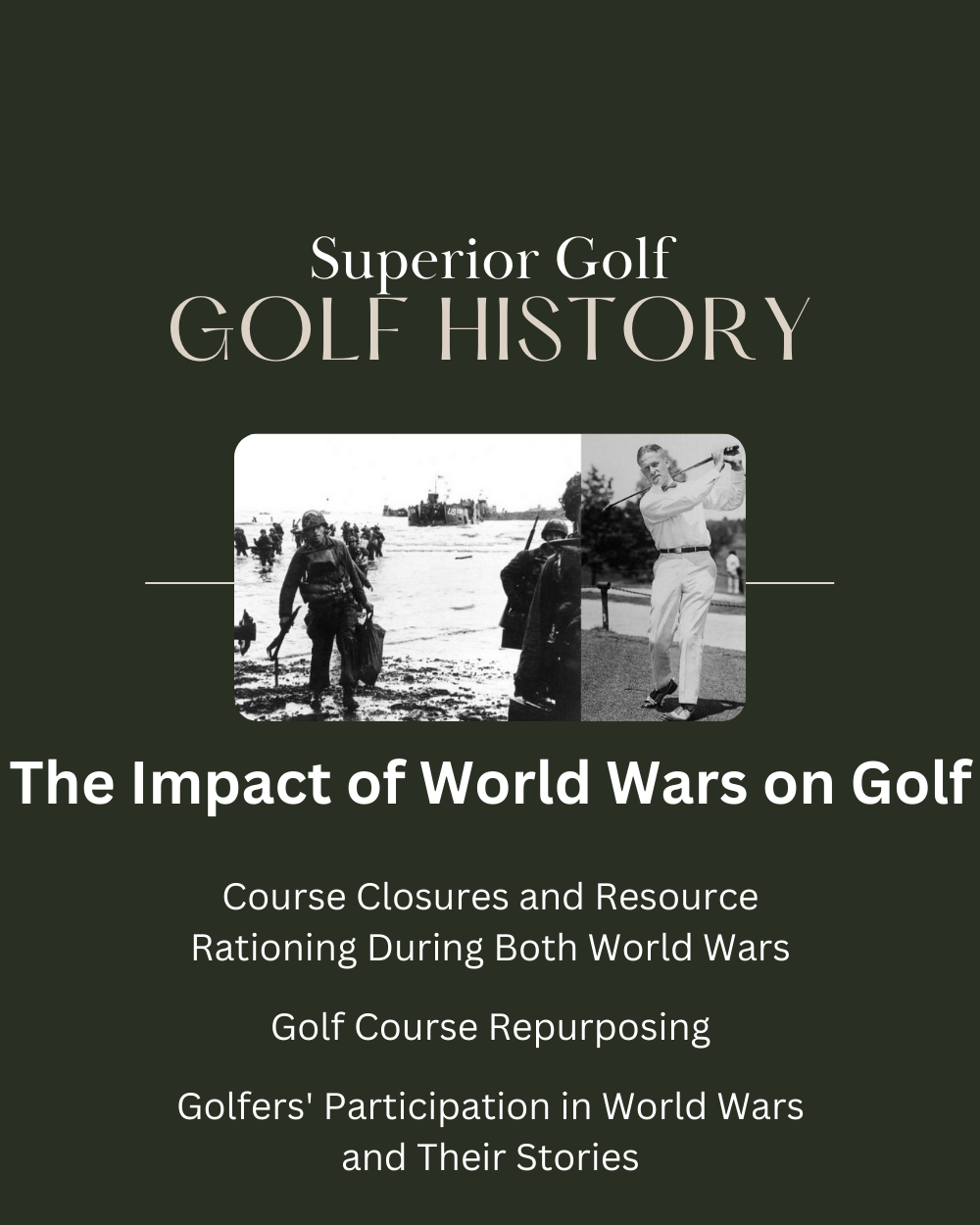The Impact of World Wars on Golf: In World War II, the US had to stop golf to focus on the war. This was like the break caused by the recent pandemic1. The halting of professional golf was a major break in its history. This only matched what happened in World War II. Back then, golf showed American patriotism and was seen as vital for health and mental well-being, according to John Kelly, a key civilian defense leader.
Famous golfers like Bobby Jones and Lloyd Mangrum didn’t just play golf; they also served their country. Bobby Jones helped start the Aircraft Warning Service and then joined the Army Air Corps1. Lloyd Mangrum fought in battles and got awards for bravery, including two Purple Hearts and other medals1.
During these tough times, people found creative ways to keep playing golf. For example, American prisoners of war made their own courses to feel normal and have fun1. These efforts show how golf could survive and thrive, even during wars. It tells a story of golf that’s tied to big events in the world.
Key Takeaways
- The stoppage of golf during World War II and the pandemic are big moments in golf’s story1.
- John Kelly talked about golf’s role in keeping fit in body and mind during war.
- Golf legends like Bobby Jones and Lloyd Mangrum mixed their sports careers with serving in the war1.
- The building of golf courses by prisoners of war shows how adaptable golf is1.
- This era highlights golf’s connection to larger national and global events, enriching its history.
Course Closures and Resource Rationing During Both World Wars
During both World Wars, golf underwent big changes. This was mainly because golf courses were closed and materials were limited. These factors impacted where golf could be played and the gear golfers could use.
Golf Course Repurposing
In World War II, many golf courses found new purposes. Fred Corcoran was key in showing how golf could aid national morale. As professional golf paused, these courses helped with the war effort.
Some golf courses were changed for army training, farming, or other key roles. This was part of a larger movement of repurposing golf courses during wartime.
This change was part of a nationwide effort to use land and resources for the war. Across the country, rationing was in place, with local boards and citizens running these programs2.
Impact of Rubber Rationing on Golf Equipment
Rubber rationing hit golf gear hard during World War II. After Pearl Harbor was attacked, tires were the first to be rationed in January 1942. This made golf balls, which need rubber, hard to find. Golfers had to find other ways to play.
Rationing hit many items, not just rubber. Sugar, coffee, and gasoline were rationed too. This meant the military had what it needed, but it also changed golf. It affected what equipment was available and how golf courses were kept up.
With tires and other items rationed, golfers and makers had to think outside the box. They used different materials or reused old gear to keep playing3.
The need to adapt led to changes in how people behave. It pushed a shift towards living more with less and being inventive3.
Despite these tough times, the golf world showed its toughness and creativity. It managed to keep the love for the game alive, proving that golf can overcome big challenges.
Golfers’ Participation in World Wars and Their Stories
Golfers in World War showed strong duty beyond just golf. Bobby Jones, a golf icon, joined the Army Air Corps. He showed great bravery in Europe after a fundraiser. His dedication was as strong in service as it was in golf.
Lloyd Mangrum, also a golf legend, joined the Army with high spirit. Known for staying calm in golf, he chose to fight in major battles like D-Day over an easy job. His bravery earned him many honors, showing these athletes’ courage.
At the Inter-Allied Games of 1919, athletes from 14 countries competed in sports like golf4. This event showed global friendship among World War golfers despite tough times.
A U.S. Army chaplain set a world record in grenade tossing at 245 feet, 11 inches4. Solomon “Sol” Butler won the long jump with a leap of almost eight meters4.
The first mention of golf in Scotland was in 14575. A law banned golf to focus on archery for warfare. These stories highlight golf’s spirit and players’ great character over time.
In 1650, settlers in Fort Orange played America’s first golf round5. This shows golf’s long bond with military service, marking its important history role.
Bobby Jones and Lloyd Mangrum showed golf’s core values of integrity and perseverance in hard times. Their war stories underline golf’s historical significance, showing its impact on and off the battlefield.
For more on the Inter-Allied Games’ history, check here. And for golf’s broader history, see this link.
Conclusion
Golf has shown its unique strength and ability to adapt, even in tough times. During World War II, the sport saw major changes. Golf courses were turned into land for war use6. Despite this, it kept its core values and was a comfort to many6.
Wars changed the world greatly. Just 15 days after President Truman became president, powerful leaders like Mussolini and Hitler were gone7. The quick end of battles in Italy and Berlin showed the need for fast decisions7. Through all these changes, golf managed to survive and even do well. Its story during these times shows its flexibility and the players’ strong spirit.
Golf will keep evolving as the world does. The challenges from the World Wars were huge, but so was golf’s response. Many soldiers in the U.S. Army were from other countries, showing America’s diversity8. This mix of cultures helped shape the future, similar to how many immigrants did in the late 19th and early 20th centuries8. Golf’s past teaches us about its lasting power and spirit.
We can expect golf to keep growing, offering joy and witnessing history. Its bright future mirrors its rich history and growth. As it holds onto its traditions and welcomes changes, golf shows its ongoing strength. To learn more about these historical events, visit the Truman Library Institute, Oxford Academic, and the World War I Centennial Commission.
FAQ
How did World War II affect the game of golf in the United States?
Were there any significant figures in golf who contributed to the war efforts?
How were golf courses utilized during World War II?
What impact did rubber rationing have on golf equipment during the wars?
How did golf showcase resilience and recovery during and after the World Wars?
What were some notable contributions of golfers like Bobby Jones and Lloyd Mangrum during wartime?
How did American POWs keep the sport of golf alive during World War II?
What were the long-term effects of World War II on the game of golf?
Source Links
- https://golf.com/news/features/soldiers-golf-world-war-ii-tough-times/
- https://www.nationalww2museum.org/war/articles/rationing-during-wwii
- https://library.csun.edu/SCA/Peek-in-the-Stacks/Rationing
- https://theworldwar.org/learn/about-wwi/inter-allied-games
- https://en.wikipedia.org/wiki/History_of_golf
- https://academic.oup.com/book/930/chapter/135504117
- https://www.trumanlibraryinstitute.org/a-look-at-trumans-influence-on-the-conclusion-of-world-war-ii/
- https://www.worldwar1centennial.org/index.php/conclusion.html

